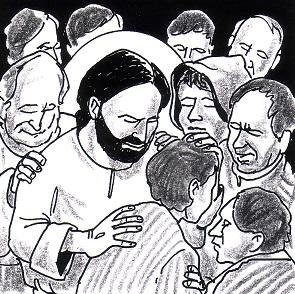
“He showed them his hands and his feet” (Luke 24:40).
Easter Thursday
The beautiful story of Emmaus continues in today’s Gospel. The two disciples whose eyes were opened at the breaking of bread rush back to Jerusalem to tell the other disciples what happened to them. Their account stirs hope in the others, and when faith rises, so does their ability to see Jesus standing right there with them. Both encounters are presented as occurring at Eucharistic gatherings. Luke’s stories give us a glimpse of the process of faith formation that was taking place in the Luke's church perhaps 50 years after the events themselves.
While we do not read the Gospel accounts for history, they do show the Easter events progressing over time with theological insights that shape our own faith. Mark’s Gospel, regarded as the earliest and one of the key sources for Matthew and Luke, has no appearance stories. Mark ends abruptly with the grieving women at the empty tomb where a “young man” tells them that Jesus has been raised. They run from the tomb bewildered and say nothing to anyone. This open-ended conclusion was Mark’s challenge to his community to affirm their own faith. A later addition will complete the story of the resurrection with appearances and the commission to preach the Gospel to the whole world.
It is Matthew and Luke, composing their Gospels a generation later, who add their own details to the story, including today’s account in which Jesus appears to the group, chides them for their hesitation to believe. He then shows them his hands and feet, invites them to touch him and even asks for something to eat. The risen Christ is not a phantom, but real.
The account seems to be addressing questions and doubts being raised by Christians in Luke’s community, most of whom never knew the earthly Jesus and were not witnesses to either his death or resurrection. Luke testifies that while their faith is not based on proof, they can be assured that the resurrection of Jesus was real—as real as flesh and blood, touching and eating, which is what they do each time they celebrate the Eucharist. It is this encounter with Jesus in Word and Sacrament, right here and now in this community, that is the basis of their faith.
This is also the basis of our faith two millennia later, which goes to say that if we are not experiencing the death and resurrection of Jesus in our own lives, our faith is still a work in progress. If we insist on proof in order to believe, we are invited in the same way Luke’s believers were invited, to see and touch the body of Christ that is the church, to feel and know the wounded hands and feet all around us and in ourselves as the focus of our love and service.
If we want miracles and visions to reassure us, who is to say these do not happen? But, they begin here, in the mystery of our life together and in our commitment to love one another as Jesus loved us.







